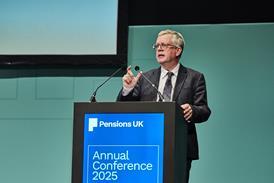Defined benefit scheme funding levels have passed 90 per cent on a s179 basis for the first time since March 2014, according to the latest edition of the Purple Book.
The Pension Protection Fund’s Purple Book 2017 paints a broadly encouraging picture of the DB landscape. The average recovery plan length has shortened to seven-and-a-half years, which is the lowest period on record since measurements began in 2005-2006.
The book did indicate that only 12 per cent of schemes now welcome new members, down from 13 per cent in 2016 and 43 per cent in 2006. The number of schemes shut to future accrual has grown to 39 per cent this year from 35 per cent in 2016.
We are seeing a declining universe reflecting schemes winding up, scheme mergers, and of course schemes entering the PPF assessment
Andy McKinnon, PPF
Long-term asset allocation shifts, away from equities in favour of fixed income, have continued into 2017.
The landscape is shrinking
The PPF compiled research based on information supplied to the Pensions Regulator by 5,588 schemes, which represents 98.5 per cent of DB schemes in the UK. This is down from 5,671 schemes in 2016.
This drop represents a fall in DB membership by about 1m people, according to the PPF.
Andy McKinnon, chief financial officer of the lifeboat fund, said: “We are seeing a declining universe reflecting schemes winding up, scheme mergers, and of course schemes entering the PPF assessment.”
He added: “There’s a relatively steady trend of schemes that have remained open, but what we’re continuing to see is that schemes that remain open to new accrual are also now closing to new members.”
Take equity risk away from members
Scheme funding reached 90.5 per cent in the year to the end of March 2017, up from 85.8 per cent in the previous year. The aggregate deficit fell to £161.8bn from £221.7bn.
Charles Cowling, director at JLT Employee Benefits, said: “This year has been pretty good for funding levels, although if you’re doing your valuation this year and your last one was three years ago, relative to three years ago, there’s some difficult conversations going on between trustees and companies.”
Negotiations between schemes and employers appear to be delivering to some extent for members, with £11.4bn in special contributions being made to schemes in 2016-17.
DB schemes have continued to lower their exposure to UK equities in favour of fixed income. Between 2006 and 2017, total equity exposure dropped to 29 per cent from 61 per cent, while UK quoted equities have fallen to 6 per cent from 29 per cent.
Allocation to bonds by DB schemes has grown to 56 per cent in 2017 from 28 per cent in 2006.
Cowling supported the basis for this trend. “There’s no upside to members taking equity risk, they don’t get any bigger benefits – they get the benefits they’re promised,” he said.
“If you look at it from a shareholder perspective [on] the benefits of taking a risk in the pension scheme… if they wanted to, they could take the same equity risk on their own balance sheet and they’d get the same benefit,” he added.
Finding the balance between pensioners and employees
Not all experts are in favour of mounting investment in fixed income and the drive among DB schemes to lower their portfolio risk.
All FTSE 350 DB schemes could be closed in 10 years
New research predicts that all defined benefit schemes of companies in the FTSE 350 index are likely to be closed to future benefit accrual within 10 years.
Nathan Long, senior pension analyst at investment platform Hargreaves Lansdown, responded positively to the general findings in the Purple Book, but expressed concern over the greater adoption of conservative investment strategies across DB schemes.
He was critical of the conservative nature of schemes' investments, which can bring greater reliance on the employer to support the scheme.
“That would be a question mark for me, because... while that shores up your defined benefit pension and your cash flows into it, it holds back how much you’re prepared to pay your current staff” as an employer, he said.














